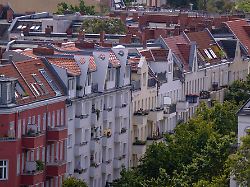“Use electricity locally”
Apartment buildings should become energy producers
21.06.2024, 15:48
Listen to article
This audio version was artificially generated. More info | Send feedback
Electricity from photovoltaic systems is becoming increasingly important in Germany. However, most systems are currently found on private homes in rural areas or on commercial roofs. One of the pioneers of renewable energies wants to change that. “Inner cities play a major role because a significant part of energy consumption takes place there,” says Sarah Debor, who is driving the concept at Naturstrom, in the podcast “Die Stunde Null”. The company was one of the pioneers of renewable energy providers in Germany and now wants to produce green electricity in multi-family homes as well.
You are demanding that the energy transition be brought into the inner cities. How should this happen?
Sarah Debor: City centers play a major role because a significant portion of energy consumption takes place there. At the same time, there are very exciting energy sources in our cities. Firstly, our roofs for electricity supply or solar thermal energy. But there are also many energy sources for heat generation that have not been sufficiently considered for a long time.
And how should these sources be used?
We would like to bring together energy consumption and production in the city. Preferably in the neighborhood, i.e. where people live.
It is now relatively common for single-family homes to have solar panels on the roof, increasingly in combination with a storage system. This is much more difficult in apartment buildings in the city. How can this change?
The federal government has a solar strategy that aims to ensure that as many roofs as possible in cities can be fitted with photovoltaics. Some cities have even introduced a solar requirement for new buildings. We believe that it is important not only to produce electricity, but also to consider what to do with it.
What does that mean?
The most efficient way is to use this electricity directly on site if possible. The technology for this is mature, but the energy industry regulations in Germany are sometimes very complex. This has led to it being easier to use the electricity from a PV system in a private home than in an apartment building.
Attempts are now being made to simplify exactly that. As a landlord in an apartment building, how do I go about producing electricity for my tenants?
Let’s take the example of the owner of a large residential building with 30 residential units – with a suitable roof. He would first have to consider whether to install the PV system himself or find someone to do it for him. The owner would then most likely contact an electricity provider who can help ensure that the electricity from the system also flows into the building. This then has to be ensured by the meter, and that basically takes care of the technical side. The landlord now has two options: either he sells the electricity from the system himself to his tenants, but then they would also have to find an electricity contract with a supplier who will provide the rest. Or the owner approaches an electricity provider who will take on the role of supplier of tenant electricity for him. This could then offer full supply, including the solar power generated by the tenants.
The modules are cheap, the federal government wants more systems – is this now a favorable environment for such projects?
Tenant electricity and decentralized concepts for energy supply remain complex. This also applies to the implementation. In addition to the costs for the technology, there is also a large chunk for project development. This is why it is still not a sure-fire success. We see a lot of interest, but a lot of convincing work still needs to be done, especially in existing buildings, before a project can be realized.
Nils Kreimeier spoke with Sarah Debor
The interview has been shortened and smoothed for better readability.
Listen in the new episode of “Zero Hour“
- How the concept of “tenant electricity” works
- What role does roof statics play for solar systems?
- How sewers are used for heat
You can find all episodes directly at RTL+, Apple or Spotify or via Google.
